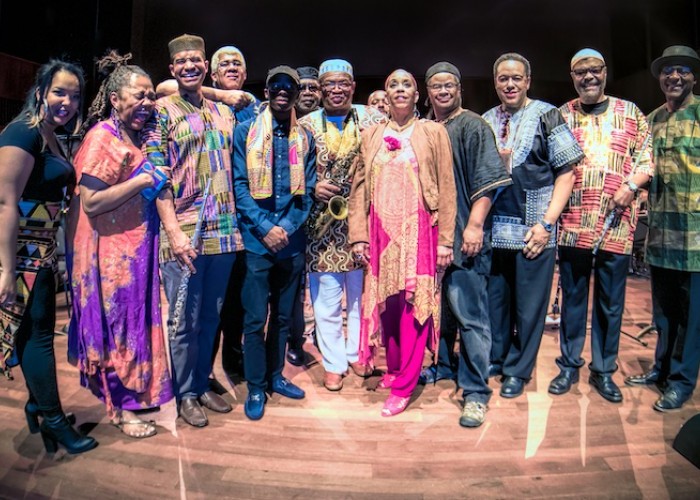Oct 28, 2025 10:47 AM
In Memoriam: Jack DeJohnette, 1942–2025
Jack DeJohnette, a bold and resourceful drummer and NEA Jazz Master who forged a unique vocabulary on the kit over his…

The AACM Great Black Music Ensemble is Alexis Lombre (left), Dee Alexander, Adam Zaonilni, Steve Berry, Frank Morrison, Ed House, Ernest Dawkins, Ben Lamar Gay, Maggie Brown, Darius Savage, Art Turk Burton, Taalib-Din Ziyad and Donovan Mixon.
(Photo: Michael Jackson)One phrase that captured me from your website was that your compositions strive to reflect the “evolving collective cultural memory of the American jazz aesthetic.” Can you explain that?
It’s about the collective cultural memory, not just of American jazz, specifically, but of the African Diaspora and American cultural aesthetic. And this is still evolving. That’s what Great Black Music is ... . It’s the collective cultural memory of the ancient to the future.
That’s why I listen—I have to listen. The music will tell me what to play when I listen, because the spiritual side of the music will tell me what to play. Now, what’s the problem? A lot of times, particularly with me, I want to impose myself. That’s when you get the autocratic channel’s sensibility of what the music should be. But when I listen, it’ll tell me what to play.
Each musician, of course, offers something unique. But recently, you lost one of your own. What did Saalik Ziyad bring to the ensemble and to Chicago’s music scene?
On that particular recording, he was playing keyboards and he was singing. He was one of the most gifted and dynamic singers around Chicago, particularly male singers. Meaning that he could sing straightahead traditional, he could sing classical. He could do various interpretations with his voice, he could manipulate his voice, make it sound like birds. He could do what we call improvisational scatting. He grew up in AACM, because his father’s in the AACM, Taalib-Din Ziyad. And myself and [reedist] Ed Wilkerson were some of his first teachers, so he kind of grew up coming to the AACM School of Music. He was one of the people that embodied the spirit of the AACM; that’s why it was such a tragedy that he passed so young.
His father’s on the line, would you me to like to add him to the call?
Yes, thank you. ... We’re interviewing Mr. Dawkins for a piece on the recording at the Currency Exchange. And it’s one of the last recordings of your son, so it’s a beautiful thing to have. I was just asking Mr. Dawkins about the vacuum left in the Chicago music community by your son’s absence.
Taalib-Din Ziyad: He was well known throughout the city, and outside of the city—he’d been to Europe several times [playing with] different configurations and musicians outside the AACM. He was a fabulous composer, an extraordinary vocalist; he could sing anything from opera to blues. In my estimation, he was one of the greatest scat singers and male vocalists around. He was very creative with his music. He even [wrote] compositions using individual’s phone numbers, very unique concepts, for the Great Black Music Ensemble. DB

Jack DeJohnette boasted a musical resume that was as long as it was fearsome.
Oct 28, 2025 10:47 AM
Jack DeJohnette, a bold and resourceful drummer and NEA Jazz Master who forged a unique vocabulary on the kit over his…

Always a sharp dresser, Farnsworth wears a pocket square given to him by trumpeter Art Farmer. “You need to look good if you want to hang around me,” Farmer told him.
Sep 23, 2025 11:12 AM
When he was 12 years old, the hard-swinging veteran drummer Joe Farnsworth had a fateful encounter with his idol Max…

D’Angelo achieved commercial and critical success experimenting with a fusion of jazz, funk, soul, R&B and hip-hop.
Oct 14, 2025 1:47 PM
D’Angelo, a Grammy-winning R&B and neo-soul singer, guitarist and pianist who exerted a profound influence on 21st…

Kandace Springs channeled Shirley Horn’s deliberate phrasing and sublime self-accompaniment during her set at this year’s Pittsburgh International Jazz Festival.
Sep 30, 2025 12:28 PM
Janis Burley, the Pittsburgh International Jazz Festival’s founder and artistic director, did not, as might be…

Jim McNeely’s singular body of work had a profound and lasting influence on many of today’s top jazz composers in the U.S. and in Europe.
Oct 7, 2025 3:40 PM
Pianist Jim McNeely, one of the most distinguished large ensemble jazz composers of his generation, died Sept. 26 at…